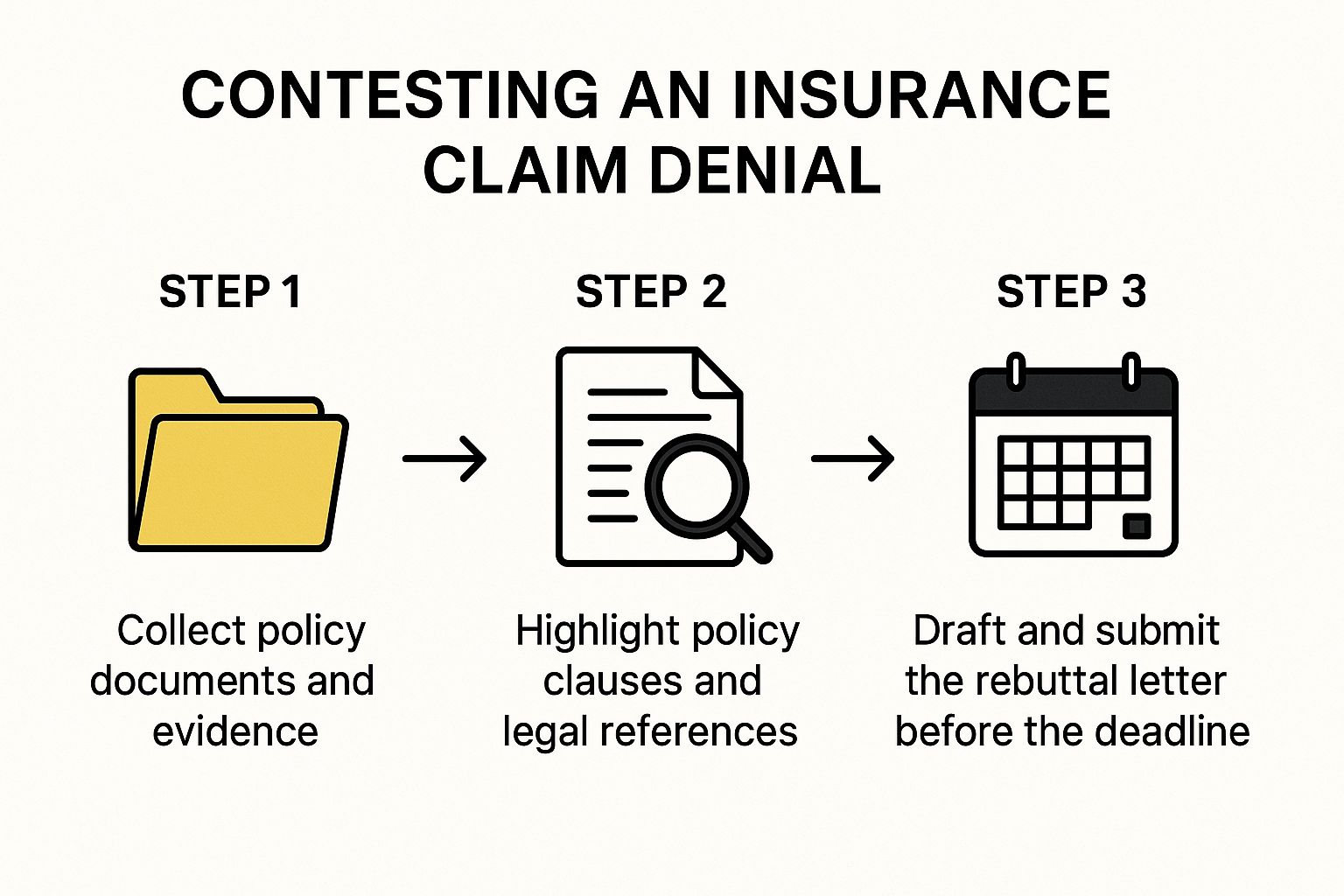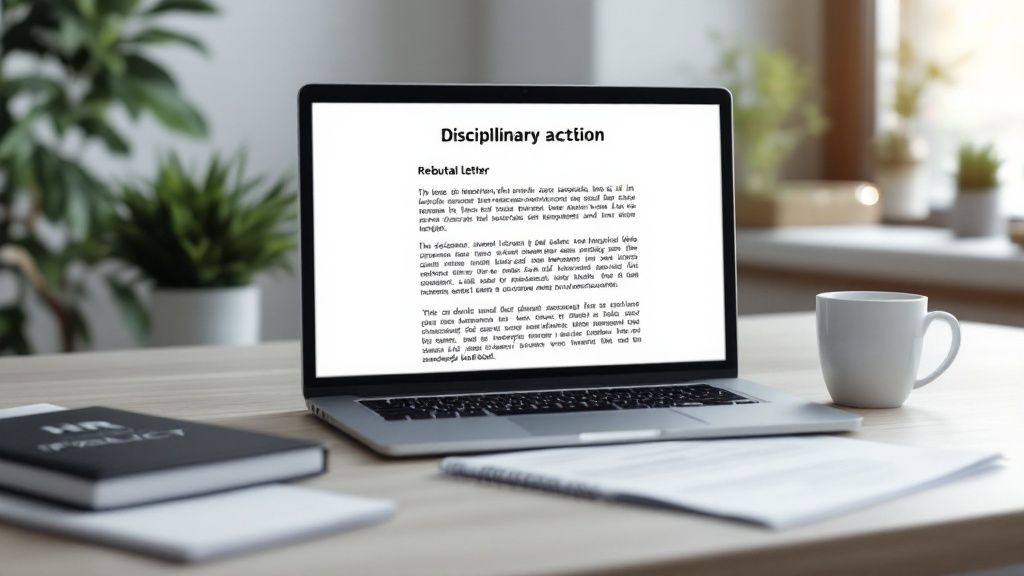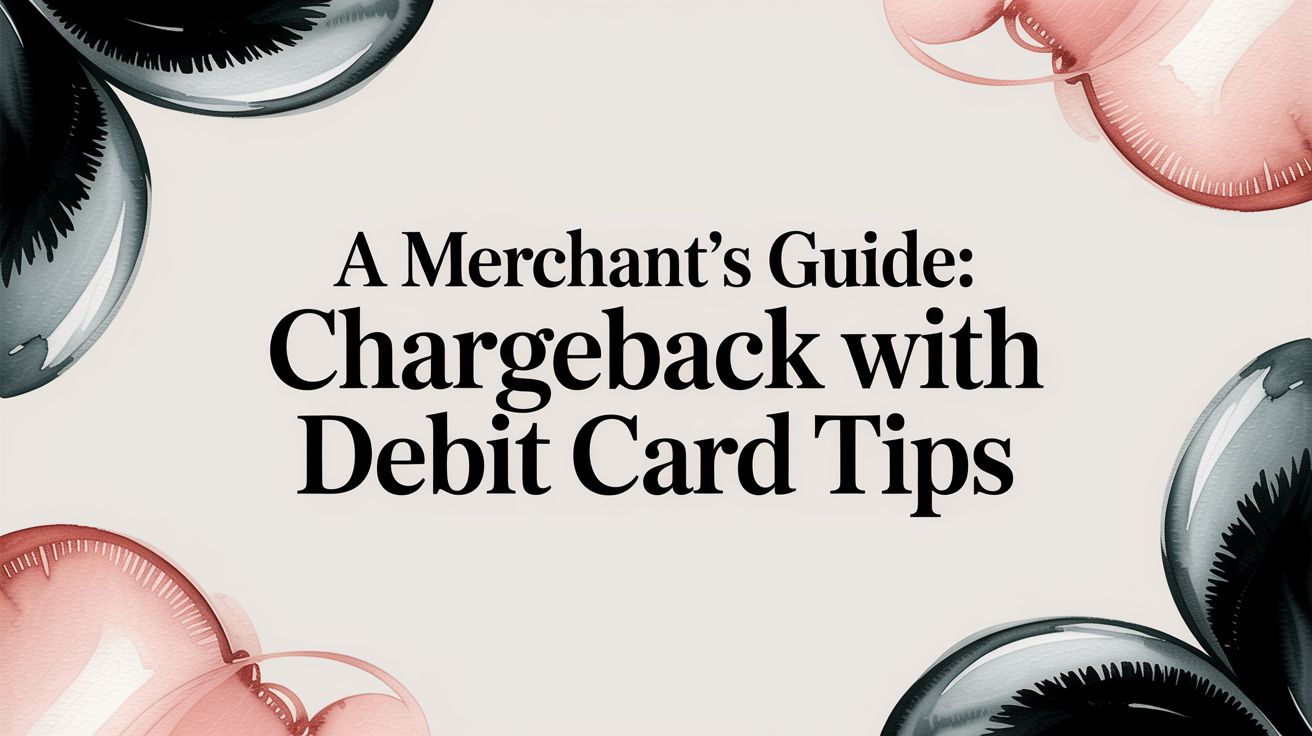
It's a sinking feeling when you open an email with a denial notice. Whether it’s a customer chargeback, an insurance claim rejection, or a harsh peer review, your first instinct might be to fire off a quick, frustrated response. But the difference between getting that decision overturned and having it finalized often comes down to the quality of your rebuttal. A generic, one-size-fits-all approach just doesn't work.
This article cuts through the noise. We're providing six tried-and-true rebuttal letter templates, each designed for a specific situation. We'll break down the strategy behind each one, showing you not just what to write, but why it works. From a formal academic peer review to a straightforward credit report dispute, you'll see how structure, tone, and solid evidence come together to build an undeniable case.
While these examples cover different fields, the core principles are universal. For e-commerce merchants dealing with a constant stream of chargebacks on platforms like Shopify or PayPal, mastering a clear, evidence-based argument is essential. These templates give you the framework to stop losing revenue to poorly written responses and start winning disputes effectively. Let's dive in.
1. Academic Journal Peer Review Rebuttal Letter Template
The academic rebuttal letter is a highly structured document researchers write to respond to feedback from peer reviewers. When a manuscript is submitted to a scholarly journal, it's checked by experts in the field. This template provides a systematic way to address their comments, strengthening the paper and increasing its chances of acceptance.

Unlike a business dispute, the goal here is to improve the work together. The tone must be respectful and friendly, even when disagreeing with a reviewer’s point. The core of this template is a point-by-point response system, making sure every piece of feedback is acknowledged and addressed directly.
Strategic Breakdown
The strength of this template lies in its organization and professionalism. By addressing each reviewer comment individually, you show you’re thorough and respect the peer review process. This methodical approach prevents you from overlooking critical feedback and shows the journal editor that you are serious about improving your work.
Key Tactic: Use a two-column format or a numbered list where you first state the reviewer's comment exactly as written and then provide your detailed response directly below it. This makes it easy for editors and reviewers to follow your changes.
This structure transforms a potentially tense process into a constructive dialogue. It guides you to thank the reviewers for their time and valuable insights, setting a positive tone from the start.
Actionable Takeaways
To effectively use academic rebuttal letter templates, follow these specific steps:
- Be Meticulous: Address every single comment, even minor ones about grammar or formatting.
- Reference Changes Clearly: Point to the exact page and line numbers in the revised manuscript where you made changes. For example, "We have revised this section as requested (see Page 5, Lines 112-115)."
- Show, Don't Just Tell: If a reviewer questions your data, consider including supplementary figures or tables in your response to support your claims.
- Disagree Gracefully: If you disagree with a comment, provide a polite, evidence-based counter-argument. Explain why you chose not to make the suggested change, citing supporting literature or data.
This approach is crucial for navigating the tough demands of academic publishing. While the setting is different, the core principles of clear, evidence-based responses apply everywhere. For a look at how these principles apply in other areas, you can find a helpful guide with an example of a rebuttal letter that showcases similar strategies.
2. Insurance Claim Denial Rebuttal Letter Template
An insurance claim denial rebuttal letter is a formal document you write to your insurance company to dispute a rejected claim. This template helps you structure a logical, evidence-based argument to challenge the insurer's decision, whether it involves a health, auto, or homeowner's policy. Its purpose is to make the insurer reconsider and overturn the denial.
This infographic outlines the core process for contesting a claim denial effectively.

Following this structured, three-step process ensures all critical parts of your appeal are organized and presented professionally, significantly improving your chances of a successful outcome.
Unlike a simple complaint, this letter is a tactical tool. It requires a factual, unemotional tone and relies heavily on citing specific language from your insurance policy to show how the denial contradicts the terms of your coverage. The goal is to prove the claim is valid according to the contract you both agreed to.
Strategic Breakdown
The power of this template comes from its methodical and evidence-driven approach. By directly referencing policy clauses and attaching supporting documents, you turn a subjective disagreement into an objective, contractual dispute. This shifts the burden of proof back to the insurer to justify their denial against the written terms of the policy.
Key Tactic: Structure your letter with clear headings: "Summary of Claim," "Reason for Denial (as stated by insurer)," "Policy Language Supporting My Claim," and "Supporting Evidence." This organization makes your argument impossible to ignore.
This formal structure shows that you are well-prepared and serious about pursuing your claim, often prompting a more thorough review from the claims department. Before writing a rebuttal, it's a good idea to understand why your claim might have been denied in the first place. Discover the common insurance claim denial reasons and how to prevent them to build a stronger case.
Actionable Takeaways
To effectively use insurance claim rebuttal letter templates, follow these specific steps:
- Reference Everything: Include your full name, policy number, and claim number in the header and opening paragraph.
- Quote the Policy: Directly quote the sections of your insurance policy that support your claim. For example, "As stated in Section III, Clause B, 'Structural damage resulting from storm-related water intrusion is covered.'"
- Compile All Evidence: Attach copies (never originals) of all relevant documents, such as medical records, police reports, contractor estimates, receipts, and photographs of damage.
- Adhere to Deadlines: Insurance companies have strict deadlines for appeals. Note the date of the denial letter and ensure your rebuttal is postmarked or electronically submitted well before the deadline expires.
This structured approach is vital for handling the complexities of insurance disputes, much like how merchants manage financial disagreements. You can learn more about how to handle these situations with effective chargeback dispute management.
3. Employment Disciplinary Action Rebuttal Letter Template
An employment disciplinary action rebuttal letter is a key document for an employee to formally and professionally respond to a negative performance review, a write-up, or other disciplinary measures. This template provides a framework for presenting a fact-based counter-story to allegations, ensuring the employee’s side is officially on record.

The main goal is to correct inaccuracies, provide missing context, and defend your professional reputation without making things worse. Unlike a casual conversation, a written rebuttal becomes part of your permanent employment file, making it a powerful tool for protecting your rights and career path. The tone must be firm and factual yet diplomatic and not confrontational.
Strategic Breakdown
The power of this template comes from its ability to turn an emotional situation into a structured, evidence-based discussion. By sticking to the facts, you remove subjectivity and focus the conversation on tangible evidence, such as referencing specific company policies or providing witness statements. This approach shows professionalism and a commitment to resolving the issue through proper channels.
Key Tactic: Structure your letter to address each point of the disciplinary action separately. Quote the specific allegation or performance critique, then immediately follow it with your factual response, including any evidence or references to the employee handbook.
This methodical response prevents you from making broad, emotional statements. Instead, it guides you to build a logical case that is difficult for HR or management to ignore, ensuring your perspective is clearly understood and documented.
Actionable Takeaways
To use employment-related rebuttal letter templates effectively, consider these steps:
- Stick to the Facts: Avoid emotional language, opinions, or accusations. Focus entirely on objective information and evidence. For example, instead of saying "My manager is unfair," state "The performance review notes my tardiness on May 5th, but my approved time-off request for that morning is on file."
- Reference Company Policy: If the disciplinary action contradicts the official employee handbook or established procedures, cite the specific policy and section number to support your argument.
- Gather Supporting Documents: Attach copies of emails, timecards, witness statements, or any other documentation that backs up your claims.
- Request a Resolution: Clearly state what you want to happen next, whether it’s the removal of the write-up from your file, a follow-up meeting with HR, or a correction to your performance review.
A well-structured letter is your best defense in a workplace dispute. For more guidance on structuring your document, you can review details on the proper rebuttal letter format to ensure your response is clear and professional.
4. Legal Motion Response Rebuttal Letter Template
A legal motion response is a formal rebuttal submitted to a court, directly opposing a motion filed by the opposing lawyer in a lawsuit. This isn't just a letter; it's a structured legal argument designed to persuade a judge. This template provides the framework for countering claims, citing legal precedent, and presenting factual evidence according to strict court rules.
Unlike more informal rebuttals, this document carries significant weight in legal proceedings. Its purpose is to dismantle the opposition's argument point by point, whether it's a motion to dismiss the case, a request for summary judgment, or a dispute over discovery. The tone must be formal, assertive, and meticulously supported by law and evidence.
Strategic Breakdown
The power of this template comes from its rigid adherence to legal standards and persuasive structure. It forces a logical, evidence-based response rather than an emotional one. By systematically addressing each argument from the opposing motion, you ensure no claim goes unchallenged and present a complete counter-argument to the court.
Key Tactic: Structure your response with a "memorandum of points and authorities." This section lists each of the opposition's arguments as a separate heading, followed immediately by your counterargument, supported by specific case law citations and references to factual evidence.
This methodical organization makes it easy for the judge to follow your logic and directly compare your position against the opposition’s. It demonstrates professionalism and a thorough command of the facts and applicable law, which is crucial for building credibility with the court.
Actionable Takeaways
To use legal response rebuttal letter templates effectively, precision is non-negotiable:
- Follow Court Rules: Adhere strictly to local court rules regarding formatting, page limits, and filing deadlines. Failure to do so can get your response rejected outright.
- Cite Controlling Law: Support every legal argument with citations to binding precedent from the correct jurisdiction. This shows the court your position is grounded in established law.
- Address Every Point: Methodically respond to every single argument raised by the opposition. Ignoring a point can be interpreted as conceding it.
- Include Necessary Documents: Attach a certificate of service, proposed orders, and any supporting affidavits or declarations as required. These procedural elements are just as important as the arguments themselves.
5. Credit Report Error Dispute Rebuttal Letter Template
The credit report dispute rebuttal is a powerful tool for consumers whose first attempts to correct errors on their credit reports have been rejected. When you dispute an inaccuracy with a credit bureau (like Equifax, Experian, or TransUnion) and they dismiss your claim, this template provides a formal, legally grounded way to escalate the issue.
This type of rebuttal letter is different because it uses consumer protection laws, mainly the Fair Credit Reporting Act (FCRA). It's not just a disagreement; it's a formal re-assertion of your rights, demanding a more thorough investigation and providing additional evidence to overturn the initial decision.
Strategic Breakdown
The strength of this template lies in its official tone and its direct reference to legal obligations. By citing specific sections of the FCRA, you change the dynamic from a simple complaint to a formal request for compliance, compelling the credit bureau to take your claim more seriously. This shows you are an informed consumer who knows your rights.
Key Tactic: Structure your letter to systematically take apart the bureau's initial rejection. Start by referencing the original dispute number, clearly state that you reject their findings, and then present your evidence point-by-point to prove the error still exists.
This approach turns a frustrating denial into a structured, evidence-based appeal. It forces the bureau to re-evaluate its decision not just based on your word, but on the documented proof you provide and the legal framework you cite.
Actionable Takeaways
To effectively use credit report rebuttal letter templates, follow these specific steps:
- Be Explicit: Clearly state, "This is a rebuttal to your findings regarding my dispute," and include the original dispute reference number.
- Cite the Law: Mention the Fair Credit Reporting Act and your right to an accurate credit report. This adds weight to your claim.
- Provide New Evidence: Don't just resend the same documents. Include new proof if possible, such as a letter from the original creditor, a corrected statement, or proof of identity theft like a police report.
- Send via Certified Mail: Always send your rebuttal letter via certified mail with a return receipt requested. This creates a legal paper trail proving the bureau received your correspondence.
This methodical process is essential for navigating disputes with large credit bureaus. While a consumer credit dispute differs from a business chargeback, many of the core principles overlap. For more insights into crafting compelling arguments, you can explore this helpful guide to rebuttal letter templates which covers a range of scenarios.
6. Patent Application Office Action Rebuttal Letter Template
A Patent Application Office Action Rebuttal is a formal response written to a patent examiner at the United States Patent and Trademark Office (USPTO). When an inventor applies for a patent, an examiner reviews the application against existing patents and legal standards. If they find issues, they issue an "Office Action" rejecting some or all of the claims. This template provides a structured way to argue against those rejections and amend the application.
Unlike a simple business disagreement, this response is a legal document governed by strict rules and deadlines. The goal is to persuade the examiner that the invention is novel, non-obvious, and eligible for a patent. The tone must be professional, precise, and grounded in patent law, addressing the examiner’s specific legal and technical arguments.
Strategic Breakdown
The power of this template comes from its methodical and legally sound structure. By responding to each rejection point-by-point, you create a clear record of arguments for the examiner and, if necessary, for future appeals. This organized approach ensures every legal and technical point raised by the examiner is properly addressed, which is critical in the high-stakes process of securing intellectual property rights.
Key Tactic: Structure your response with distinct sections for each rejection. For example, have a separate heading and argument for a "Rejection under 35 U.S.C. § 102" (novelty) and another for a "Rejection under 35 U.S.C. § 103" (obviousness). This makes your rebuttal easy for the examiner to follow and evaluate.
This format turns a complex legal debate into a clear, persuasive dialogue. It forces you to build a logical case for patentability, citing specific evidence from your application or providing new evidence through inventor declarations.
Actionable Takeaways
To effectively use patent application rebuttal letter templates, follow these specific steps:
- Address Every Rejection: Respond to each and every ground of rejection raised by the examiner. Failure to address even one point can result in the application being abandoned.
- Amend Claims Strategically: Modify the patent claims to narrow their scope and distinguish them from the "prior art" cited by the examiner. Clearly explain why the amended claims are now patentable.
- Provide Detailed Support: When arguing a point, reference the exact page and line numbers in your original patent specification that support your claims. For example, "Support for this limitation is found in the specification at page 8, lines 15-20."
- Argue Gracefully and Legally: If you disagree with the examiner's interpretation of prior art or law, present a respectful, well-reasoned counter-argument citing relevant case law or technical facts.
This disciplined approach is essential for navigating patent prosecution. While the legal framework is unique, the core strategy of presenting a structured, evidence-based argument is similar to what's needed to win a credit card dispute and other formal rebuttal processes.
Rebuttal Letter Template Comparison
From Templates to Triumphs: Your Next Move
We've explored a wide range of situations, from academic peer reviews to patent office actions, breaking down exactly what makes a rebuttal letter effective. Across every example, a clear pattern emerges. The most successful rebuttals are not just letters; they are structured, evidence-based arguments designed to persuade a specific audience.
Whether you're responding to an insurance denial or a credit report error, the core principles stay the same. A calm, professional tone sets the stage, a logical structure guides the reader through your points, and solid evidence serves as the foundation of your entire case. These elements transform a simple dispute into a powerful, convincing response.
Key Takeaways for Stronger Rebuttals
Mastering the art of the rebuttal letter is about shifting your mindset from reactive defense to proactive strategy. Here’s a summary of the most crucial lessons:
- Structure is Everything: A disorganized letter is a losing letter. Always start with a clear summary, address each point systematically with its own evidence, and conclude with a firm, polite call to action. This creates a roadmap for the reviewer to follow, leading them directly to your desired conclusion.
- Evidence is Your Ally: Your opinion is not enough. You must anchor every claim with concrete proof. This could be a timestamped communication, a policy clause, a signed document, or a detailed log of events. The stronger and more relevant your evidence, the harder your claim is to dismiss.
- Audience-Centric Tone: Always write for the person on the other end. An academic reviewer requires a different tone than a credit bureau agent. Keep it professional, objective, and free of emotional language. Your goal is to make it easy for them to agree with you.
Applying These Lessons to Your Business
While the templates provided cover different fields, for an e-commerce merchant, these lessons hit closest to home when dealing with chargebacks. Each chargeback is a dispute that costs you not only the sale amount but also processing fees and your valuable time. Manually crafting a detailed response for every single dispute is a huge drain on resources.
This is where using rebuttal letter templates becomes essential for protecting your bottom line. You can apply the same principles: structure your response, attach the right evidence (like shipping confirmations and customer communications), and maintain a professional tone. However, as you grow, the sheer volume can become overwhelming. Thinking about the next evolution of this process is key. For those weighing their options, understanding the differences between AI drafting versus legal templates can provide clarity on building a more scalable, modern rebuttal strategy. You now have the frameworks to fight back effectively, but the real victory lies in automating the fight itself.
You have the templates to build a strong defense against chargebacks. But if you're ready to stop fighting manually and start winning automatically, it's time to see what AI-powered automation can do for your business. Explore how ChargePay can take this entire process off your plate, turning lost revenue into reclaimed profit and freeing you to focus on growth.







.svg)







.svg)
.svg)
.svg)